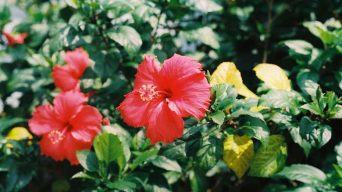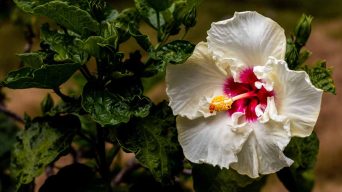Holes in hibiscus leaves can be caused by pests like sawflies, aphids, Japanese beetles, earwigs, grasshoppers, and wind damage or disease. Use insecticidal soap or vinegar spray to prevent holes and keep grasshoppers and crickets away.
Hibiscus plants are renowned for their stunning, vibrant flowers that bring life to any garden or indoor space.
However, holes in hibiscus leaves can cause concern and detract from the plant’s beauty.
Here we’ll explore common causes of these leaf holes, such as pest infestations, diseases, environmental factors, and nutrient deficiencies.
We’ll also discuss strategies to identify the culprit behind the damage and offer practical solutions to help restore your hibiscus plant’s health and prevent future issues.
Causes Of Holes In Hibiscus Leaves
Hibiscus leaves may develop holes due to multiple causes, such as pests, diseases, environmental factors, and nutrient deficiencies.
These factors can adversely affect the plant’s health and growth, causing damage to the leaves and affecting the overall appearance of the Hibiscus.
It is important to identify the underlying cause of the holes in hibiscus leaves and take appropriate measures to prevent further damage to the plant.
Pest Infestations
Pest infestations are a common culprit behind the holes in the leaves of your hibiscus plant.
Various insects, such as aphids, Japanese beetles, caterpillars, earwigs, and grasshoppers, can cause significant damage to your beloved hibiscus plants by chewing through the foliage.
One example of a pest specifically targeting Hibiscus is the mallow sawfly (Atomacera decepta).
Sawfly larvae are voracious feeders undergoing several growth stages before becoming adult sawflies.
These tiny green worms chew small holes in leaves during their early stage of development and gradually eat more significant portions of foliage as they mature.
These pests can defoliate an entire plant in severe infestations in just a few days.
Diseases
Diseases can also cause holes in hibiscus leaves, leading to unsightly damage and compromised plant health.
One common disease affecting hibiscus plants is anthracnose, which presents as brown spots on the leaves that eventually develop into holes.
Early detection is crucial to combat these diseases and protect your beautiful hibiscus plants.
Keep an eye out for changes in leaf coloration or texture and promptly remove any infected leaves to prevent further spread.
Applying fungicides specifically designed for hibiscus diseases may be necessary if infections become more severe or widespread.
Environmental Factors
Various environmental factors can also contribute to the development of holes in leaves, making it imperative for hibiscus plant enthusiasts to be aware of and address these conditions.
For instance, high humidity levels can encourage fungal diseases such as leaf spot or root rot, leading to discolored and weakened leaves that eventually develop holes.
Furthermore, an inadequate water supply can stress your hibiscus plant and make it more susceptible to damage from pests or diseases. Overwatering may lead to root rot, while underwatering dries out the soil and roots, leading to wilting leaves with eventual tearing or hole formation.
To maintain a healthy environment for your tropical Hibiscus, regularly monitor moisture levels by keeping the soil moist but well-drained throughout its growing season, providing appropriate indirect sunlight exposure, and maintaining adequate temperature ranges between 60-90°F (16-32°C).
Nutrient Deficiencies
Another possible cause of holes in your hibiscus leaves is nutrient deficiencies. Hibiscus plants require a balanced amount of nutrients to function correctly and stay healthy.
If they lack vital minerals, such as magnesium or iron, it can cause their leaves to develop unsightly holes.
One sign that your plant may struggle with mineral deficiencies is chlorosis or yellowing of the leaves.
You must provide the appropriate nutrients for your hibiscus plant to address this issue.
Consider using a fertilizer specifically formulated for acidic-loving plants like Hibiscus, which typically contains a balance of essential minerals like nitrogen, phosphorus, and potassium, along with micronutrients like magnesium and iron.
Identifying The Culprit: Signs And Symptoms
If you’ve noticed holes in the leaves of your Hibiscus, it’s essential to identify the cause of the problem to take the right steps for treatment.
The first step is to inspect the plant for any signs of pests or diseases.
Next, check for any environmental factors that may be causing damage to the plant.
Finally, test the soil for nutrient imbalances.
Following these methods, you can determine the culprit behind the holes in your hibiscus leaves and take necessary measures to address the issue.
Inspecting The Plant For Holes And Discoloration
Regular inspection of your hibiscus plant is crucial in identifying signs and symptoms of holes and discoloration.
Start by examining the leaves, looking for small or large holes and areas that have turned yellow or brown.
Check both sides of the leaves, as most pests tend to lay eggs underneath them.
If you notice sawfly larvae munching away at your hibiscus buds or caterpillars feeding on foliage, immediately take action.
Inspecting your plants regularly can help you catch issues early, making it easier to address them before they become more severe.
Checking For Signs Of Pests Or Disease
Identifying the culprits behind the holes in your hibiscus leaves is important. Checking for signs of pests or diseases can help pinpoint the problem.
Some common symptoms of pest infestations on hibiscus plants include yellowing leaves, wilting stems, browning edges, and webbing.
You may also notice tiny holes in the foliage caused by insects like Japanese beetles or hibiscus sawflies.
In addition to pests, diseases like leaf spot and mealybugs can also cause damage to your plant.
Identifying Environmental Factors That May Be Causing Damage
Environmental factors can also impact the health of hibiscus plants and cause holes in their leaves.
Poor air quality, temperature extremes, and insufficient sunlight are some environmental stressors that can lead to damage.
To identify these factors, carefully inspect the plant for any visible signs of stress or damage, such as discoloration on the leaves or wilting flowers.
Check your local weather conditions and ensure your Hibiscus receives enough water and sunlight for its specific needs.
Testing Soil For Nutrient Imbalances
Testing the soil is crucial in determining whether nutrient imbalances are causing holes in your Hibiscus leaves.
This can be done by sending soil samples to a laboratory for analysis or using at-home testing kits to give you results within minutes.
It’s important to note that too much fertilizer can also cause damage to your Hibiscus plant, so it’s essential to follow instructions on the packaging carefully.
Regular soil testing throughout the growing season can help prevent nutrient imbalances from becoming severe enough to impact plant health and lead to further problems like wilting and yellowing of leaves.
Solutions To Prevent And Treat Holes In Hibiscus Leaves
Proactive measures can be taken using organic pest control techniques to protect hibiscus plants from leaf damage.
For disease prevention and treatment, applying fungicides or bactericides is recommended.
Regular pruning of damaged leaves and adjusting environmental factors can also help.
Addressing nutrient deficiencies through soil amendments is crucial in maintaining healthy hibiscus plants.
Use Organic Pest Control Methods
Organic pest control methods are highly effective in managing pests that cause holes in leaves.
These eco-friendly solutions use natural predators or insecticides, rather than synthetic chemicals, to protect the plants from infestations.
Encouraging the growth of beneficial insects like ladybeetles and dragonflies is one method of luring pests away from hibiscus flowers while providing a natural habitat for these creatures.
Additionally, neem oil and insecticidal soap can deter insects like spider mites or aphids without harming pollinators like bees or butterflies.
Apply Fungicides Or Bactericides For Disease
If the cause of holes in leaves is a disease, then applying fungicides or bactericides can be an effective solution.
These products help to prevent and treat diseases associated with damaged leaves, such as bacterial leaf spot and black spots on leaves.
When choosing a fungicide or bactericide, consider using safer organic options for beneficial insects and the environment.
Bacillus thuringiensis is one example of an organic option that can effectively control caterpillar infestations without harming other insects.
Horticultural oil is another natural product that helps control insect pests and prevents fungal infections like powdery mildew.
Prune Damaged Leaves And Adjust Environmental Factors
When dealing with holes in leaves, addressing the underlying causes is important to prevent further damage.
Pruning damaged leaves is a crucial step in maintaining plant health and preventing the spread of disease or pest infestations.
Adjusting environmental factors such as light and temperature can also help prevent holes from forming in Hibiscus leaves.
For example, too much direct sunlight can lead to leaf scorch, while cold temperatures may cause wilting or stunted growth.
Additionally, ensuring proper drainage and avoiding overwatering is essential for preventing root rot which can quickly set in and compromise the entire plant.
Add Soil Amendments To Address Nutrient Deficiencies
Hibiscus plants require certain nutrients to grow and thrive, and a lack of these nutrients can cause holes in leaves.
Adding soil amendments such as compost or organic fertilizers can help address nutrient deficiencies in the soil.
For example, if the leaves turn yellow due to a lack of iron, adding iron sulfate or chelated iron to the soil can help green up the foliage.
It’s important to test your soil before adding any amendments so that you know exactly what your plant needs.
Final Thoughts
Holes in hibiscus leaves can be a frustrating problem for any plant enthusiast.
However, it is possible to prevent and treat this issue by identifying the culprit and implementing proper solutions.
From managing pest infestations with organic methods to addressing nutrient deficiencies through soil amendments, various options are available to keep your hibiscus plants healthy and beautiful.







